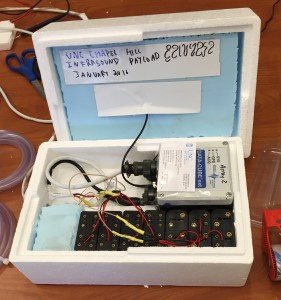
While the Compton Spectrometer and Imager (COSI) gazes into space, another experiment is listening for whispers from the Earth itself. Housed in two humble white boxes tucked behind COSI’s solar panel, a triad of microphones are recording infrasound – sound too deep for humans to hear. Infrasound sources include volcanoes, earthquakes, ocean waves, the aurora, explosions, rocket launches…and many more.
The power of infrasound lies in its ability to travel vast distances. Higher frequency sounds dissipate rapidly: this is why bass notes carry much further than treble notes, and why thunder from a nearby lightning strike is a sharp crack, as opposed to the muffled boom of a faraway storm. The exceptionally deep sounds in the infrasound range can travel around the world multiple times.
Networks of ground-based infrasound detectors are located around the world. The sensitivity of these microphones can be their own worst enemy, however. The slightest gust of wind can overwhelm faint acoustic waves from the other side of the planet. Also, the temperature structure of the troposphere (the lowest layer of the atmosphere) tends to channel sound waves away from the Earth’s surface.
Infrasound sensors on balloons may offer significant advantages. Since they move at the same speed as the wind, they never feel its effects. Modeling suggests they can record sounds at much greater distances compared to those on the ground, and perhaps detect signals that never reach the surface at all. Despite this, no infrasound microphones have been deployed above 8 kilometers from the early 1960s to 2014, a gap of over half a century. Thus, the true diversity of atmospheric sounds remains unknown.
The infrasound payload on board the super pressure balloon was developed by the University of North Carolina at Chapel Hill. The exceptionally light (<3 kg) instrument package has three primary objectives: 1) characterize the sound field of the stratosphere 2) record an “event” (earthquake, bolide, etc) and 3) quantify the impact of local acoustic or electromagnetic noise from COSI and the balloon itself.
If successful, this experiment will collect the most infrasound data ever recorded during a single flight; indeed it will increase the time coverage of available acoustic data in the stratosphere by an order of magnitude. The detection range and sensitivity of free flying acoustic stations will be well characterized, and the magnitude of humanity’s contribution to the global infrasound wave field will be quantified.
Unlike COSI, however, the data are not telemetered. The recorder must be recovered, or the microphones will take their secrets to the bottom of the sea. Thus, the UNC team watches nervously as the superpressure balloon drifts across the open ocean, and crosses their fingers that nothing goes wrong.
Listen to previous infrasound recordings here: https://soundcloud.com/nasa/sets/high-altitude-student-platform
Danny Bowman, University of North Carolina at Chapel Hill
